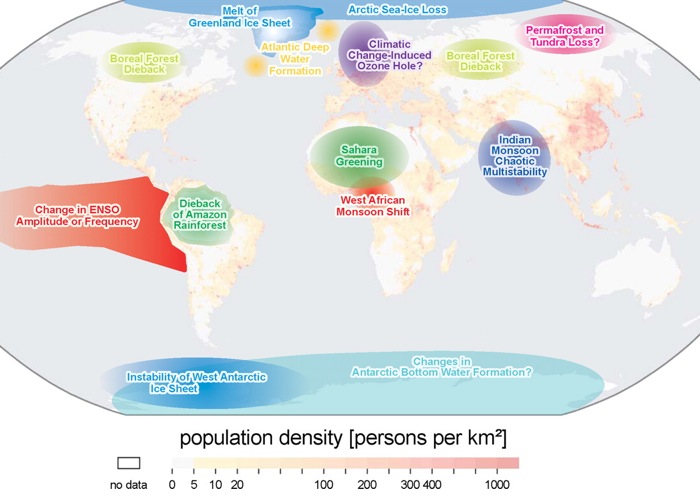Difference between revisions of "Climate"
m (Text replacement - "http://nordan.daynal.org" to "https://nordan.daynal.org") |
m (Text replacement - "http://" to "https://") |
||
| Line 2: | Line 2: | ||
==Etymology== | ==Etymology== | ||
| − | *Date: [ | + | *Date: [https://www.wikipedia.org/wiki/14th_Century 14th century] |
[https://nordan.daynal.org/wiki/index.php?title=English#ca._1100-1500_.09THE_MIDDLE_ENGLISH_PERIOD Middle English] climat, from Middle French, from Late Latin climat-, clima, from [[Greek]] klimat-, klima inclination, from klinein to lean | [https://nordan.daynal.org/wiki/index.php?title=English#ca._1100-1500_.09THE_MIDDLE_ENGLISH_PERIOD Middle English] climat, from Middle French, from Late Latin climat-, clima, from [[Greek]] klimat-, klima inclination, from klinein to lean | ||
<center>For lessons on the [[topic]] of '''''Climate''''', follow [https://nordan.daynal.org/wiki/index.php?title=Category:Climate '''''this link'''''].</center> | <center>For lessons on the [[topic]] of '''''Climate''''', follow [https://nordan.daynal.org/wiki/index.php?title=Category:Climate '''''this link'''''].</center> | ||
| Line 12: | Line 12: | ||
*3 : the prevailing [[influence]] or [[environmental]] conditions characterizing a [[group]] or period : atmosphere <a climate of [[fear]]> | *3 : the prevailing [[influence]] or [[environmental]] conditions characterizing a [[group]] or period : atmosphere <a climate of [[fear]]> | ||
==Description== | ==Description== | ||
| − | '''Climate''' [[encompasses]] the [[statistics]] of [[temperature]], [ | + | '''Climate''' [[encompasses]] the [[statistics]] of [[temperature]], [https://en.wikipedia.org/wiki/Humidity humidity], [https://en.wikipedia.org/wiki/Atmospheric_pressure atmospheric pressure], [https://en.wikipedia.org/wiki/Wind wind], [https://en.wikipedia.org/wiki/Rainfall rainfall], atmospheric particle count and other meteorological elements in a given region over long periods of [[time]]. Climate can be [[contrasted]] to [[weather]], which is the present condition of these same elements and their variations over periods up to two weeks. |
| − | The climate of a location is affected by its latitude, terrain, and altitude, as well as nearby [[water]] bodies and their currents. Climates can be [[classified]] according to the [[average]] and the typical ranges of [[different]] [[variables]], most commonly [[temperature]] and [[precipitation]]. The most commonly used [[classification]] [[scheme]] was [[originally]] [[developed]] by [ | + | The climate of a location is affected by its latitude, terrain, and altitude, as well as nearby [[water]] bodies and their currents. Climates can be [[classified]] according to the [[average]] and the typical ranges of [[different]] [[variables]], most commonly [[temperature]] and [[precipitation]]. The most commonly used [[classification]] [[scheme]] was [[originally]] [[developed]] by [https://en.wikipedia.org/wiki/Wladimir_K%C3%B6ppen Wladimir Köppen]. The Thornthwaite system, in use since 1948, incorporates [https://en.wikipedia.org/wiki/Evapotranspiration evapotranspiration] in addition to [[temperature]] and [[precipitation]] [[information]] and is used in [[studying]] [[animal]] [[species]] [[diversity]] and [[potential]] impacts of [https://en.wikipedia.org/wiki/Climate_change climate changes]. The Bergeron and [https://en.wikipedia.org/wiki/Spatial_Synoptic_Classification_system Spatial Synoptic Classification] systems [[focus]] on the [[origin]] of [[air]] masses that define the climate of a region. |
| − | [ | + | [https://en.wikipedia.org/wiki/Paleoclimatology Paleoclimatology] is the [[study]] of ancient climates. Since direct [[observations]] of climate are not available before the 19th century, paleoclimates are inferred from proxy variables that include non-biotic [[evidence]] such as sediments found in [[lake]] beds and ice cores, and biotic [[evidence]] such as tree rings and coral. [https://en.wikipedia.org/wiki/Climate_model Climate models] are [[mathematical model]]s of [[past]], [[present]] and [[future]] climates.[https://en.wikipedia.org/wiki/Climate] |
==See also== | ==See also== | ||
'''''[[Climate Change]]''''' | '''''[[Climate Change]]''''' | ||
Latest revision as of 23:42, 12 December 2020
Etymology
- Date: 14th century
Middle English climat, from Middle French, from Late Latin climat-, clima, from Greek klimat-, klima inclination, from klinein to lean
Definitions
- 1 : a region of the earth having specified climatic conditions
- 2 a : the average course or condition of the weather at a place usually over a period of years as exhibited by temperature, wind velocity, and precipitation
- b : the prevailing set of conditions (as of temperature and humidity) indoors <a climate-controlled office>
- 3 : the prevailing influence or environmental conditions characterizing a group or period : atmosphere <a climate of fear>
Description
Climate encompasses the statistics of temperature, humidity, atmospheric pressure, wind, rainfall, atmospheric particle count and other meteorological elements in a given region over long periods of time. Climate can be contrasted to weather, which is the present condition of these same elements and their variations over periods up to two weeks.
The climate of a location is affected by its latitude, terrain, and altitude, as well as nearby water bodies and their currents. Climates can be classified according to the average and the typical ranges of different variables, most commonly temperature and precipitation. The most commonly used classification scheme was originally developed by Wladimir Köppen. The Thornthwaite system, in use since 1948, incorporates evapotranspiration in addition to temperature and precipitation information and is used in studying animal species diversity and potential impacts of climate changes. The Bergeron and Spatial Synoptic Classification systems focus on the origin of air masses that define the climate of a region.
Paleoclimatology is the study of ancient climates. Since direct observations of climate are not available before the 19th century, paleoclimates are inferred from proxy variables that include non-biotic evidence such as sediments found in lake beds and ice cores, and biotic evidence such as tree rings and coral. Climate models are mathematical models of past, present and future climates.[1]
